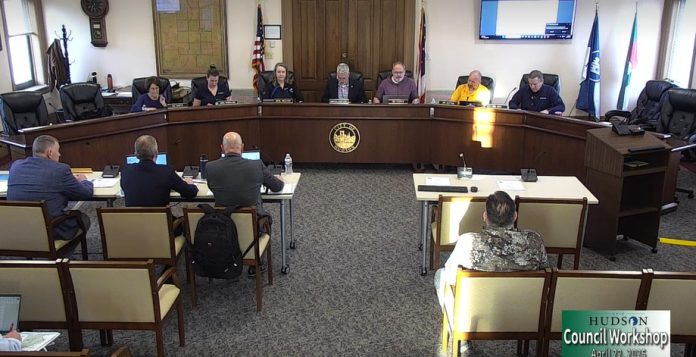In a lengthy workshop meeting Tuesday evening, the Hudson City Council discussed several important matters including neighborhood storm water studies, downtown development concepts, and a concerning five-year financial outlook for the city’s fire and EMS department.
City Engineer Brad Sheridan presented findings from targeted storm water studies of areas severely impacted by the August 8th flooding event, which was classified as a 500 to 2,000-year storm. Staff and consultants identified several potential improvement projects, including pipe upgrades near Rosewood Grill and potential detention areas in Darrow Park that could benefit multiple neighborhoods downstream.
“We found some ideas, some projects that I think we are going to kickstart and we can get expedited into construction in 2026 if the budget will allow,” Sheridan told council members.
Discussions then moved to downtown development plans for Phase 2, with Community Development Director Greg Heath presenting several concept options that align with the 2024 Comprehensive Plan. The concepts featured varying housing densities (ranging from 20-60 units) and public space options, including a community facility or market hall.
Council member Nicole Kowalski voiced concerns about the housing layout, noting it reminded her of a previously rejected plan. “Definitely because of the TIFF I feel like concept 3 is better, but it feels a little bit packed and tight, and I would love to see in the neighborhood area like a pocket park,” she suggested.
The most serious discussion centered on the city’s updated five-year financial plan presented by Finance Director Jeff Knoblauch, which showed the fire and EMS fund potentially being depleted within seven years under the proposed hybrid fire department staffing model. The staffing change would cost approximately $1.1 to $1.2 million per year.
“Despite what some people would say, funds within the city of Hudson are not unlimited,” Council President Christopher Foster noted, adding that the city would need to either reallocate tax revenue or potentially seek additional funding through a property tax levy.
Council member Skylar Sutton expressed strong concerns: “I don’t think it’s a fair comparison to say don’t build this bridge that has fallen into our laps in place of the fire station,” referring to the Hines Hill Bridge project. “We’ve got to find a long-term solution for the fire fund.”
Despite financial concerns, most council members supported moving forward with the first phase of the hybrid fire department model, which would provide staffing from 7 a.m. to 7 p.m. seven days a week.
The council also briefly discussed but did not approve a proposed senior gutter cleaning program similar to one implemented in Macedonia, with several members citing the previous financial discussion as a reason to delay such initiatives.
The next regular council meeting is scheduled for May 6th, as next week would normally be a fifth Tuesday with no scheduled meeting.
Discover more from Northeast Ohio News
Subscribe to get the latest posts sent to your email.











